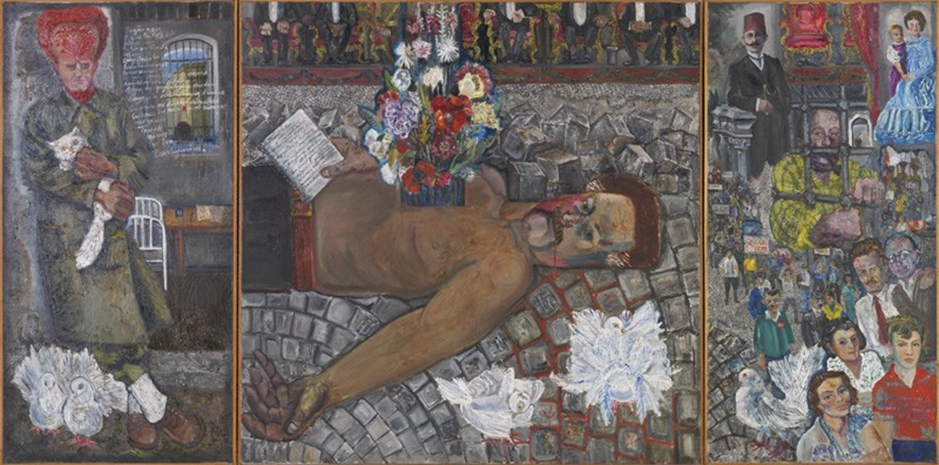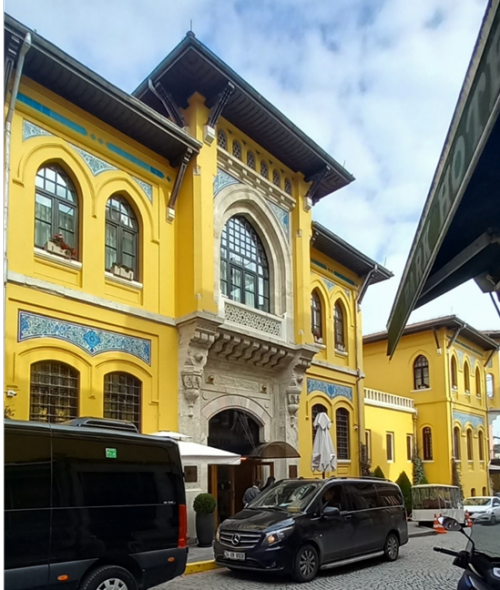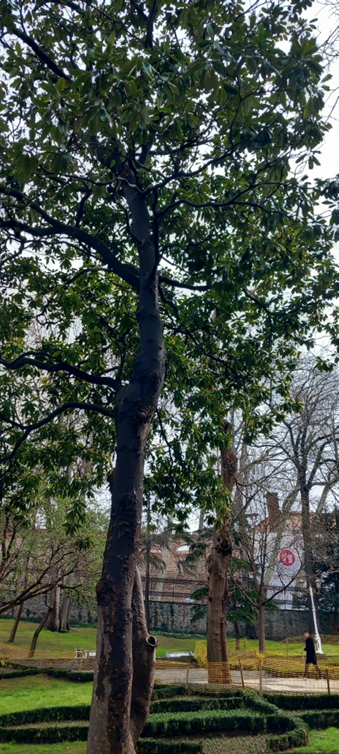
The painting shown above, titled Death of the Poet, was painted in 1967 by Cihat Burak (1915–1994) and can be admired at Istanbul Modern, which hopefully will open again soon. On a rainy afternoon in November 2021, I spent a long time observing this colorful triptych.
It depicts the life and death of the famous Turkish poet, playwright, and novelist Nâzım Hikmet (1902–1963). In a semi-biographical fashion, Burak painted several key episodes and aspects of Hikmet’s eventful life: his early upbringing in a wealthy Ottoman family in Istanbul (top right); the almost fifteen years he spent in prisons across Turkey, a result of his communist sympathies (left); his innovative free-verse poetry, scribbled on the prison walls and bursting from his mind (top left); and, his enduring impact on new generations of protesters (right center). Instead of reiterating Hikmet’s biographical facts here—excellent biographies and introductions are available in English[1]—I want to use this blog post as an opportunity to follow some of the poet’s steps in Istanbul, the city he loved so much and missed so dearly while he was in prison, and later, during his exile in Russia and Bulgaria.[2] I hope that, by tracing Nâzım Hikmet’s Istanbul through poetry and photographs, some well-trodden places in the city may acquire new poetic layers.[3]

Our Nâzım-walk begins on Beyazit Square, the spacious stepped plaza with grey cobblestones in front of the elaborate gate to Istanbul University. Standing on the square, we see people moving in all directions, on their way to attend lectures, to go shopping in the Grand Bazaar, or to be on time for prayer at the nearby Beyazit Camii. Flocks of pigeons also cross the open space, frightened by the constant stream of traffic on the adjacent Ordu Caddesi or attracted by generous tourists sharing their simit. Nowadays, nothing on Beyazit Square reminds one of the tragedy that happened here approximately sixty years ago. A poem by Nâzım Hikmet, titled In Beyazit Square, however, vividly remembers what occurred:
In Beyazit Square
A dead man lies,
a youth of nineteen years,
in the sun by day,
under the stars by night,
in Istanbul, in Beyazit Square.
A dead man lies,
in one hand a notebook,
in one hand his dream gone
before it began, in April 1960,
in Istanbul, in Beyazit Square.
A dead man lies
shot
a bullet-wound
like a red carnation open on his forehead,
in Istanbul, in Beyazit Square.
A dead man will lie,
his blood seeping into the earth
until my country comes with arms and freedom songs
and takes
the great square
by force.
(Original title: Beyazıt Meydanı’ndaki Ölü , transl. by Ruth Christie, from Beyond the Walls, p. 218)[4]
Nâzım wrote this poem in May 1960 as a reaction to the student protests of the so-called “28–29 April Events” (28–29 Nisan Olayları) that took place in Istanbul and Ankara in April of that year. While socio-political unrest had already been building in Turkey for some time—not least because of a strong devaluation of the Turkish Lira and the related rise in commodity prices—these protests were particularly targeted at the authoritarian and repressive rule of the center-right Democrat Party (DP) which ruled in Turkey between 1950 and 1960. The Republican People’s Party (CHP), forming the political opposition, was increasingly curtailed by bans on political gatherings, and İsmet İnönü, the party’s leader, was obstructed and even attacked while campaigning. The immediate cause of the protests was the installation of the so-called Committee of Inquest (Tahkikat Komisyonu), which effectively acted as a political court that imprisoned political opponents. During the Istanbul protests on Beyazit Square, the police used excessive violence against the protesting crowd. Besides hundreds of injured students and staff members, a 19-year-old student in Forestry Studies, Turan Emeksiz, was shot in the head and killed.
On the central panel of Burak’s painting, the death of Nâzım Hikmet is situated on Beyazit Square, purposefully conflating the poet’s death with that of his poem’s subject, Turan Emeksiz. This poetic license—Hikmet was not actually killed on the streets but died from a heart attack in Moscow—makes sense: it is likely that Nâzım wrote his poem because he felt a strong affinity with the much younger Turan. The painted metamorphosis and the triptych composition both add to the poem’s theme of resurrection, further evoking its suggestion that each generation produces new heroes, new voices against oppression and social injustice. Years before the horrible events of April 1960, Nâzım had already written about this theme in the magnificent epic poem about Sheikh Bedreddin, a fifteenth-century ‘socialist’ peasant in western Anatolia, whose short-lived revolt was ultimately violently suppressed by the Sultan—staged by Hikmet as a preview of the twentieth-century social revolts he so much supported (“When we say Bedreddin will come again we are saying that his words, his eyes, his breath, will come again through our midst”).

While contemplating these prophetic words, we take Ordu Caddesi and walk to Sultanahmet Square. On the southern side of that square, you can see an imposing building that is strikingly yellow. Between 1938 and 1939, and again in 1950, Nâzım was imprisoned here. The Sultanahmet Jail, also known as the Dersaadet Cinayet Tevkifhanesi (Dersaadet Murder Jail), was one of the most notorious prisons of the city, particularly used to imprison writers, journalists, intellectuals, and artists that were considered political dissidents. Orhan Kemal, a good friend of Nâzım and another influential Turkish author, also spent time behind bars here.[5] Nowadays, the building has been repurposed to accommodate the wealthy, serving as the luxurious environs of the Four Seasons Hotel. The hotel proudly advertises its former use as a prison, exclaiming on their website that “It’s not every day you get to stay in a century-old Turkish prison, refurbished for luxury living.” Nâzım Hikmet wrote several poems during his imprisonment here; the following one was written in 1939. I fantasized about reciting it out loud to hotel guests entering and leaving the building or writing it as graffiti on those tempting yellow walls:
In Istanbul, in Tevkifane Prison Yard
In Istanbul, in Tevkifane prison yard,
A sunny winter’s day after the rain,
Clouds, red roof tiles, walls and my face
Trembling in the puddles on the ground.
I am so brave in my spirit, so cowardly,
Whatever there is, strong or weak,
I carry it all,
I thought of the world, my country, and you…
(Original title: İstanbul’da, Tevkifane avlusunda, transl. by Richard McKane, from Beyond the Walls, p. 97)

From the Sultanahmet Prison, we continue our tour, walking across Sultanahmet Square, passing the Hagia Sofia, and then turning right to Gülhane Park, behind Topkapı Sarayı. For once, you are allowed to ignore all these well-known touristic attractions! Instead, go into the park and try to find a walnut tree like the one on the picture. Then read the following poem:
The Walnut Tree
My head is a foaming cloud, inside and outside I’m the sea.
I am a walnut tree in Gülhane Park,
an old walnut tree with knots and scars.
You don’t know this and the police don’t either.
I am a walnut tree in Gülhane Park.
My leaves sparkle like fish in water,
my leaves flutter like silk handkerchiefs.
Break one off, my darling, and wipe your tears.
My leaves are my hands—I have a hundred thousand hands.
Istanbul I touch you with a hundred thousand hands.
My leaves are my eyes, and I am shocked at what I see.
I look at you, Istanbul, with a hundred thousand eyes,
And my leaves beat, beat with a hundred thousand hearts.
I am a walnut tree in Gülhane Park.
You don’t know this and the police don’t either.
(original title: Ceviz Ağacı, transl. by Richard McKane, from Beyond the Walls, p. 197)
This popular poem was written while Nâzım traveled to Balçık (Bulgaria), where he stayed in exile. In some sense, it evokes a feeling of absence, the fate of a fugitive in hiding; the author seems to yearn for his Istanbul roots—a recurrent theme in his later work, especially. A romantic but unverified story goes that Nâzım based the poem on a memory of Gülhane Park from several years before, when he was already sought after by the police. While waiting in the park to meet secretly with his former lover Piraye, he witnessed two cops approaching in the distance, who had been tipped off by an untrustworthy ‘friend.’ Not knowing where to run, Nâzım allegedly decided to climb the nearest walnut tree and hid among its foliage. From there, he saw how the cops, but also Piraye, were looking for him—in vain. Many Turkish people know The Walnut Tree by heart, not in the least through rock musician Cem Karaca’s famous interpretation. Like Nâzım himself, it has become a symbol of resistance. The poem acquired further prominence during the 2013 Istanbul Gezi Park protests, when it featured on the banners and in speeches of the defenders of the park and its trees.[6] As is well known, this peaceful sit-in ended in an extremely violent eviction by the police, killing 22 people and injuring thousands. Returning from Fatih back to ANAMED, you might want to take a little detour and consider Gezi Park the last stop of this poetic resistance walk.
My leaves are my eyes, and I am shocked at what I see. From Bedreddin to Turan Emeksiz to Gezi. Looking at Istanbul through his poems and through the canvas of Burak’s painting, Hikmet would probably still be shocked at what he saw today.
———————————————————————————————————————–
[1] Edward Timms and Saime Göksü, Romantic Communist: the life and Work of Nâzım Hikmet (London: Hurst, 1999).
[2] Some caveats are in place here: I am not a literary scholar, let alone a specialist on the work of Hikmet. I merely write about this subject as a passionate reader of his poetry. Furthermore, I realize many more places and poems could have been included here. Among these, I should definitely mention the Nâzım Hikmet Kültür Merkezi in Kadıköy, which has a great bookstore and a lovely tea garden.
[3] Poetry schmoetry, what about the white cat in the painting?! It seems that Burak painted a so-called Van cat (Van kedisi), which are known for their fluffy white fur and heterochromic eyes; the cute specimen in the painting has a blue and a yellow eye. Hikmet wrote about the presence of cats in the prisons where he stayed (see, for example, the poem Lodos,which was written in Bursa prison), but most likely the painted cat is a reference to the third poem Hikmet ever wrote, Samiye’nin Kedisi, an ode to the old and scruffy cat of his sister Samiye.
[4] I will provide several citations from Hikmet’s work, in English translation. Although I believe in Robert Frost’s dictum that poetry is what gets lost in translation, I think Hikmet’s poetry deserves to be read by non-Turkish readers also. Fortunately, excellent translations are available; I quote primarily from the 2002 volume Nâzım Hikmet. Beyond the Walls. Selected Poems, with translations by Ruth Christie, Richard McKane, and Talât Sait Halman, the latter of whose insightful introduction I also used.
[5] Orhan Kemal and Nâzım Hikmet did not spend time together in this prison. They had become friends in the Bursa Prison, where they stayed between 1940 and 1943. Kemal’s moving memoir In Jail with Nâzım Hikmet (2012, translated by Bengisu Rona) gives a detailed account of these early years. The small but charming Orhan Kemal Museum in Cihangir, not far from ANAMED, also contains some pictures and letters attesting to their friendship.
[6] See Kim Fortuny’s excellent article “Nâzım Hikmet’s ecopoetics and the Gezi Park protests;” Fortuny 2016, Middle Eastern Literatures 19, no. 2: 162–84.

